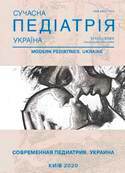Epidemiology of antibacterial resistance in children with urinary tract infection: dynamics for 2009 2019 and its impact on the disease course
Keywords:
urinary tract infection, children, Escherichia coli, antibacterial resistanceAbstract
The rapid rate of antibiotic resistance (ABR) among children with urinary tract infection (UTI) dictates the need for a comprehensive study of its prevalence, nature, the prognosis for understanding management mechanisms.The aim. Study of the epidemiology of ABR in hospitalized children and adolescents with UTI, evaluation of the rate of selection of resistant E. coli strains over the past 10 years and the impact of ABR on the disease course.
Materials and methods. The prevalence of resistant E. coli (ABR) strains depending on age and gender was studied in a total cohort of patients with UTI (n=2754) aged 1 month. up to 18 years for the period 2009–2019. The dynamics and rates of E. Coli ABR development were investigated in 3 comparison groups: group I — children in 2009 (n=337), group II — 2014 (n=328), III group — 2019 (n=379).
Results. The prevalence of ABR in children with UTI is shown: every two children had resistance (57.6%±1.6 (1586/2754)) and every 3–4 children had polyresistance (27.4%±3.04 (755/2754)). Resistant uropathogenic strains are more commonly reported in children aged 1–3 years and 4–6 years, both among boys (25/95 (26±16.91) vs 27/95 (28±16.04)), and among girls (417/1491 (28±4.07) vs 477/1491 (32±3.7)). Under the age of 1 year, boys (more often than girls) had resistance (8/95 (9±33.33) vs 75/1491 (5±11.03), p=0.039) and polyresistance (3/53 (5±55.48) vs 14/702 (2±25.95), p=0.034). The statistically significant advantages of polyresistance in boys aged 7–12 years (17/53 (33±19.78) vs 154/702 (22±6.98), p=0,021) and in girls aged 1–3 years (175/702 (25±6.42) vs 8/53 (16±32.23), p=0.04). Resistance among E. coli strains has increased by 11% over the past 5 years and by 19% over 10 years, reaching 70%±4.06 (176/252) in 2019. The proportion of E. coli polyresistant strains among patients with resistance in 2019 was 40%±9.12 (70/176). The mathematical prediction of the prevalence of resistant E. coli strains after 15 years approached 100% (y=9.5×6+41=98%) at R2=0.9918. After 10 years, the indicator corresponded to 88.5%, and after 5 years — 79%. The relative risk of reinfection (RR) in patients in 2019 had statistically significant benefits compared to even the last 5 years (RR2014=1.130±0,224 [0.728; 1.753] vs RR2019=1.496±0,195 [1.021; 2.191], p<0.05). A high Pearson correlation was found between high-strength correlation between E. coli resistance and reinfection in children (ρ=0.975, p<0.05).
Conclusions. The results of the study revealed the prevalence of ABR among children with UTI over the past 10 years, determined the pace and prognosis of its development, emphasized the impact on the formation of recurrent course of this pathology.
Patient screening and interpretation of the results were conducted within the framework of the Helsinki Declaration.Автор заявляет об отсутствии конфликта интересов.
References
Ahn DH, Kim KW, Cho HK, Tchah H et al. (2015). Febrile Urinary Tract Infections Caused by Community-Acquired Extended-Spectrum beta-Lactamase-Producing and-Nonproducing Bacteria: A Comparative Study. Pediatr Infect Vaccine.22: 29–35. https://doi.org/10.1016/j.eimc.2016.01.012; PMid:26976379
Aragon IM, Herrera-Imbroda B, Queipo-Ortuno MI, Castillo E et al. (2018, Jan). The Urinary Tract Microbiome in Health and Disease. Eur Urol Focus.4(1): 128–138. https://doi.org/10.1016/j.euf.2016.11.001; PMid:28753805
Brubaker L, Wolfe AJ. (2017, Feb). Microbiota in 2016: Associating infection and incontinence with the female urinary microbiota. Nature Reviews Urology.14(2): 72–74. https://doi.org/10.1038/nrurol.2016.262; PMid:28050013 PMCid:PMC5522000
Bryce A, Costelloe C, Hawcroft C et al. (2016). Faecal carriage of antibiotic resistant Escherichia coli in asymptomatic children and associations with primary care antibiotic prescribing: a systematic review and meta-analysis. BMC Infect Dis 2016.16: 359. https://doi.org/10.1186/s12879-016-1697-6; PMid:27456093 PMCid:PMC4960702
Calzi A, Grignolo S, Caviglia I, Calevo MG et al. (2016, Sep). Resistance to oral antibiotics in 4569 Gramnegative rods isolated. Eur J Pediatr;175(9): 1219–25. https://doi.org/10.1007/s00431-016-2763-1; PMid:27558493
Kim SH, Lee JA. (2015). The impact of the antibiotic burden on the selection of its resistance among gram negative bacteria isolated from children. Pediatr Infect Vaccine.22: 178—85. https://doi.org/10.14776/piv.2015.22.3.178
Lee SJ. (2018, Dec 21). Recent advances in managing lower urinary tract infections. F1000Res.7. pii: F1000 Faculty Rev-1964. https://doi.org/10.12688/f1000research.16245.1; PMid:30613378 PMCid:PMC6305210
Magistro G, Stief CG. (2019, Jan). The Urinary Tract Microbiome: The Answer to All Our Open Questions? Eur Urol Focus.5(1): 36–38. https://doi.org/10.1016/j.euf.2018.06.011; PMid:30042043
Mantadakis E, Vouloumanou EK, Panopoulou M, Tsouvala E et al. (2015). Susceptibility patterns of uropathogens identified in hospitalised children with communityacquired urinary tract infections in Thrace, Greece. J Glob Antimicrob Resist. 3: 85–90. https://doi.org/10.1016/j.jgar.2015.02.006; PMid:27873675
Martin Bland. (2015). An introduction to medical statistics: Oxford University Press. 4th edition: 464 pp. ISBN 978-0-19-958992-0
Whiteside SA, Razvi H, Dave S, Reid G, Burton JP. (2015, Feb). The microbiome of the urinary tract — a role beyond infection. Nat Rev Urol.12(2): 81–90. https://doi.org/10.1038/nrurol.2014.361; PMid:25600098
Wolfe AJ, Brubaker L. (2019, Feb). Urobiome updates advances in urinary microbiome research. Nat Rev Urol.16(2): 73–74. https://doi.org/10.1038/s41585-018-0127-5; PMid:30510275 PMCid:PMC6628711
Downloads
Issue
Section
License
The policy of the Journal “MODERN PEDIATRICS. UKRAINE” is compatible with the vast majority of funders' of open access and self-archiving policies. The journal provides immediate open access route being convinced that everyone – not only scientists - can benefit from research results, and publishes articles exclusively under open access distribution, with a Creative Commons Attribution-Noncommercial 4.0 international license (СС BY-NC).
Authors transfer the copyright to the Journal “MODERN PEDIATRICS. UKRAINE” when the manuscript is accepted for publication. Authors declare that this manuscript has not been published nor is under simultaneous consideration for publication elsewhere. After publication, the articles become freely available on-line to the public.
Readers have the right to use, distribute, and reproduce articles in any medium, provided the articles and the journal are properly cited.
The use of published materials for commercial purposes is strongly prohibited.

